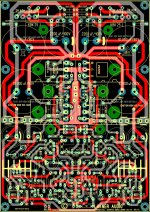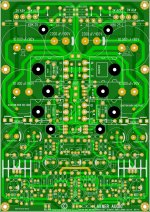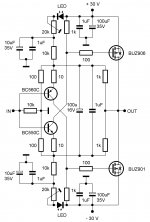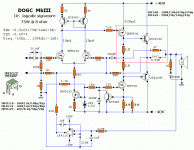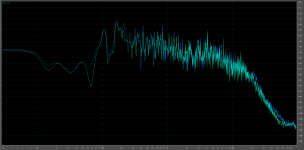PCB - AUDIO ART of EXCELLENCE
Alex,
Pure beauty of PCB ART . . .
Congrats !

. . .final layout . . .
Regards Alex.
Alex,
Pure beauty of PCB ART . . .

Congrats !

@Jay
If anything here is 100% tested than it would be BIGBT.
In term of stability and measured performance, I have no doubt. Unfortunately, many good sounding amps are less stable and have higher THD. Most often the following is correct:
Add more components to the circuit ---> More stable
Add more components to the circuit ---> Better measured performance
Remove more components from the circuit ---> Better sounding
So I believe in critically implemented "simple" circuit (complicate the power supply if necessary). The output stage of a BIGBT doesn't look simple (one high capacitive mosfet, one PBJT and one NBJT working on the same signal), and for an "ultimate" amp I will not consider such output stage. Of course, I'm not talking as an electronics expert, far from that. But I believe that when/if later I build it I will hear a "high end" and "clinical" sound. I remember some of us who had built/heard IGBT amps. Many of my friends were "impressed" but AFAIK non of us are living with the "incredible" amps.
Choosing the parts imo as a builder is important. I know at least 2 transistors (forgot the types) that I think should be considered instead of the IRF610/9610.
As for VAS, I have tried to figure out why TO-92 usually outperforms bigger part. BF470/472 has an outstanding suitable parameters in the datasheet, but I have always suspected, either the transistor itself, or the cascode that give the "negative" sound, or both. The only parameter where BF472 is inferior than MPSA42 (or 2N5551) is the current capability. May be BF472 was optimized for high voltage video application that it was less suitable for many amp implementation (especially mosfet driver)? But you may say that in the intended application, we don't need better current capability (even Hitachi uses a 50mA SB716). Well, like I said, I don't know, I'm just trying to find explanation for something that I observe soundwise.
So what I'm after (for lateral based amp) is a TO-92 driver. For V rail close to 75V, MPSA42 and 2N5551 is my favourite. Haven't compared the best of them but I guess MPSA42 (or even MPSA43) will win, if audible. Both of them are 625mW. I think that will be the limitation in the design. But it is still "doable", isn't it (to get the circuit working at approx. 70W output and higher than 250V/uS SR for what this TO-92 can handle)?
Add more components to the circuit ---> More stable
Add more components to the circuit ---> Better measured performance
Remove more components from the circuit ---> Better sounding
I think that is true!
But I'm in for 2 boards here.
Alex, your design of boards is art, I think that you don't use auto placing of component and auto routing of tracks i think you do that manualy, that's why is art.
Add more components to the circuit ---> Better measured performance
Remove more components from the circuit ---> Better sounding
I think that is true!
But I'm in for 2 boards here.
Alex, your design of boards is art, I think that you don't use auto placing of component and auto routing of tracks i think you do that manualy, that's why is art.
Add more components to the circuit ---> More stable
Add more components to the circuit ---> Better measured performance
Remove more components from the circuit ---> Better sounding
. . . . . But I believe that when/if later I build it I will hear a "high end" and "clinical" sound.
Choosing the parts imo as a builder is important. I know at least 2 transistors (forgot the types) that I think should be considered instead of the IRF610/9610.
Haven't compared the best of them but I guess MPSA42 (or even MPSA43) will win, if audible.
Trouble is Jay we all have different ideas about what a "good" sound is. Your three aphorisms don't match with my experience of approaching my "good" sound. My offerings would be
1) ANY measures that reduce "noise" including noise the on the earth rail = better sound.
2) more stable = better sound, even more stable = even better sound BUT has to be fast enough so that even after stabilzation measures it's still fast enough to sound good.
3) Adding a compensation cap should be the LAST measure resorted to for good stability
Don't quite see How Clinical can be "High End"
Over on the Fetzilla thread a few of us were very impressed with how much better ZVP3310a sounded as compared with IRF9610 - Have you tried 3310 ? If so do you think MPSA42 is still better.
JLH observed that symmetrical amps had a more "detailed" sound than similar specified S/E designs - but I wonder if that was something to do with noise levels.
p.s.
4) Also passive components make a big difference - most capacitors & resistors sound bad
Last edited:
Just a dressed simple symmetrical amplifier instead of a naked one ;-)
We are sure on the same wavelenght Christophe.

Lazycat
the big attraction for me was the simplicity and low transistor count/cost, and that a pcb may be forthcoming. Obviously something a beginner could make without too much effort and cash outlay. The fact that the design can be used to fulfill many people's needs/wants is testament to a good design, but it would have been nice to start out with the simple design, tested, before going for a full blown monster.
I know exactly what you mean Bryan, that's the reason why I started this thread in the first place. The schematics posted ranges from very simple to complex ones and some unconventional ideas were presented and how to implement them in a simple way. If someone is willing to learn, absorb something about amps, schematics, designing PCB's etc., this thread has also educational purpose to some degree. Many known and well experienced forum members commented, placed their versions of their preferred SSA solution, even started their own threads based on SSA, Alex took tour de force of the PCB designing with so many SSA PCB-s that never happened before in a one thread ...
So Bryan if there is a beauty in simplicity, here's the simplest SSA version of them all just for you.
Best regards, Andrej

Attachments
The output stage of a BIGBT doesn't look simple (one high capacitive mosfet, one PBJT and one NBJT working on the same signal), and for an "ultimate" amp I will not consider such output stage. Of course, I'm not talking as an electronics expert, far from that. But I believe that when/if later I build it I will hear a "high end" and "clinical" sound. I remember some of us who had built/heard IGBT amps. Many of my friends were "impressed" but AFAIK non of us are living with the "incredible" amps.
Choosing the parts imo as a builder is important. I know at least 2 transistors (forgot the types) that I think should be considered instead of the IRF610/9610.
Hi Jay
BIGBT internal schematic is a complex looking only on a first sight but in reality (when it becomes familiar) this is simple and incredible output transistor. Yes truly, I consider it as one part only, it actually acts like that.
Output BJT's share the same base current so collector currents are of identical waveform (also can be in absolute value terms if they are hFE matched), only one base current loads driver mosfet like there it would drive only one output BJT (halves power dissipation, doubles hFE - transconductance), you get positive side of both kind of output topology at the same time - common collector and common emitter configuration of the outputs, ease of driving (only have to charge small capacitance of the mosfet gate input) means lower power dissipation in VAS. Regarding speed, ease of drive (very simple front-end), immunity to oscillations, etc., I posted many real Tektronix's HF plots so everything is obvious. And the sound of all mine amps who's having BIGBT-s is better than any usual common emitter output stage.
Last edited:
But I'm in for 2 boards here.
Alex, your design of boards is art, I think that you don't use auto placing of component and auto routing of tracks i think you do that manualy, that's why is art.
Wait to my version of this PCB and than decide ...
... "auto placing" was performed by mine "little grey cells"
Lazy.. have you ever explored this topology in the preamp domain...??
If it could be made with 3-6 dB Gain.. I Think I could be very good...
From all tests until now and really low noise (absolutely no hiss noticed from tweeters) I consider this topology very recommendable for preamp purposes but unfortunatelly I didn't have enough time yet to be involved in that direction.

Trouble is Jay we all have different ideas about what a "good" sound is. Your three aphorisms don't match with my experience of approaching my "good" sound. My offerings would be...
"Good" sound is something that you like so much, that you don't want to be departed with, and you cannot stand to listen to something else. Enjoyment in listening to music is very rare that you will know when you experience it.
So good sound is about good feeling. That's the first idea.
Second idea is about what make or give the good feeling. This is not yet technical. This is a bit subjective as everyone has different priority. For example, my ears are very sensitive to any kind of distortion. My friend owned a KT88 amp. Everytime I came by and had a chat, I wanted him to turn off his system. Not because of the amp, but the Fostex! How can I have a good feeling if I feel my ears hurt? So I put the in-existence of this kind of distortion at higher priority than him.
The first priority I guess is what I call "sonic" as this is what mostly determines musicality. Something that makes you want to dance. And also there is ability of the system to reproduce "emotion", thing that makes you happy and want to sing along. All of these are 100% "non-electronics".
Third idea is about what technical parameter determines the qualities stated above. Basically to know how each of the slew rate, noise, CMRR, dynamic range, THD, IMD, etc will affect our feeling.
1) ANY measures that reduce "noise" including noise the on the earth rail = better sound.
Everyone will agree, except in prioritization. The question is, when we improve the noise performance, do we sacrifice other performance?
When we hear a noise/hum when the volume is low, then we have a problem. Increasing the volume will make this noise/hum to be pushed to background, but it is still there, prohibiting us to hear the micro detail that will give the effect of sound-stage, even (I guess) emotion.
2) more stable = better sound, even more stable = even better sound BUT has to be fast enough so that even after stabilzation measures it's still fast enough to sound good.
3) Adding a compensation cap should be the LAST measure resorted to for good stability
It depends. We often hear that instability/oscillation may trick the ears, as second harmonics do, into hearing something nice. I don't have a problem with stability soundwise. As long as it doesn't bring fire/damage, it is okay. Because cdom, bucherot, or anything that you add to improve stability do not contribute at all to good sound. So why not improve stability by making a perfect trace/PCB (even PTP wiring), for example, instead of increasing the cdom.
"High end" sound is the sound associated with high end (expensive) equipments.Don't quite see How Clinical can be "High End"
I'm not sure if my "clinical" is the same with others "clinical". Compare Bipolar amps in general with mosfet amps. Bipolar amps sound more clinical, mosfet amps sound more warm.
Over on the Fetzilla thread a few of us were very impressed with how much better ZVP3310a sounded as compared with IRF9610 - Have you tried 3310 ? If so do you think MPSA42 is still better.
Of course I know. You know what, I will know if one mosfet will sound better than other mosfet (in most audio circuit) by only looking at the input capacitance. Transconductance is never the limiting factor in practice.
But I don't get it. Why you relate the mosfets with MPSA42?. I always prioritize or start with observation soundwise, only then I check the technical parameters to see what makes thing sound as it does. I may be wrong with the cause, but not the phenomena that I observe.
For some reasons we all have heard, we want high slew rate, especially for mosfet amps. Together with the benefit of high power, we need higher supply rail. Now, many "good" transistors are limited by Vce. BC556 is 65V, ZTX692 is 70V, 2SA970 is 120V, 2N5401 is 150V, MPSA42 is 300V, BF472 is 300V. So from the supply rail I'm shooting for, the low noise BC transistors are out.
The next limiting factor to use TO-92 in drivers is power capacity. MPSA42 and 2N5401 are both 625mW. Most TO-92 are below 500mW.
MPSA42 are from Motorola. 2N5401 are from many suppliers. National Semiconductors produces unacceptable 2N5401 in term of hfE. KSP's are consistently very high.
I cannot measure fT and Cob, but from spec, MPSA is most probably better in Cob but most probably worse in fT. Here I think the Cob will have more impact (both below 6pF).
JLH observed that symmetrical amps had a more "detailed" sound than similar specified S/E designs - but I wonder if that was something to do with noise levels.
Observed details are usually in higher frequencies. Non-symmetrical amps have higher distortion at higher frequencies (even tho a nice second order one). They also have lower power supply rejection (no cancellation?).
But the main problem (which is rarely thought of) with sound reproduction imo is PHASE. I learn this from speaker building. I have a high slew rate requirement for amps because of this phase issue. I know how phase can ruin everything that is required for an enjoyable sound.
Is it merely because of the output stage (common emiter)?And the sound of all mine amps who's having BIGBT-s is better than any usual common emitter output stage.
Regarding speed, ease of drive (very simple front-end), immunity to oscillations, etc., I posted many real Tektronix's HF plots so everything is obvious. And the sound of all mine amps who's having BIGBT-s is better than any usual common emitter output stage.
I have no doubt with the goodies associated with the front end. Imo, people should start to modify many known amps with your SSA input. I believe there will be good amps produced in the short future

Output BJT's share the same base current so collector currents are of identical waveform (also can be in absolute value terms if they are hFE matched),
We know that it is never 100% identical. And hfE match happens only in simulation. It is expensive transistor. How many is required to get one matched pair? This imprecision is imo very critical. I don't know about electronics, but may be you have seen how Borivoje Jagodic treated the output (attached)
Attachments
10Hz ----> 100KHz
Andrej,
Your's explanation of the BW needed for the most accurate sound playback is one of the most correct one anyone ever mentioned here in any of the playback need debate.
I wonder if You please change the (SONY-constraint "Deaf" stereotype -20Hz-20KHz) and live it in the dust, and please accept the "more realistic" one from what is really happening in the real life-like classical concert music event... 10Hz -100KHz bandwidth.
10Hz -100KHz bandwidth.
I'm sure You'll agree the more super-sonic informations in the music source the more pleasant -life-like it is, and Yours AMP-design philosophy is the proof of this concept.
Yours AMP-design philosophy is the proof of this concept.
When as much real music lovers will realize and hopefully have the chance and experience with "real" Hi Res. music sources, (not just money-grabing UP-Sampled ones) they will get the feel for the "must" need to obtain the "real Hi-Res recorded" sources with as much super-sonic informations possible, .. all the rest inferior sources (CD-MP3) would be of no valid need any more.
My wish is to happened this to as many music lovers to at least once experienced the "real feel" of a true life-like event at his own homes, I'm sure, after that experience, the wish, to go back to the red-book constraint would be minimized to minimum-mostly to un-awaill. sources only.
Right here Yours Amp design philosophy come in in it's all real valued (now hidden) potential.
I do much appreciated Yours will to give the music lovers a chance to at least listen by them self what is really important and needed for the best possible natural recreation in an amp - music playback.
For anyones to see this graphically I attach the img. (DSD-1bit-5,6MHz Fs) with the recorded real live piano playing - (super-sonic characteristic) which clearly shows that the music informations existed well below the current (DEAF-red-book standard 20Hz-20KHz) it is actually present all the way to the 60 KHz, the mechanical limit of the rec. mic.

Somebody would ask himself, why on this world he is performing 2 MHz testing only, what intriguing reason for that it would be?
Well, 2 MHz is only 100 times more than 20 kHz and according to my opinion, if we want to produce uncompromising power amplifier at least that 100 times higher bandwidth conditions must be well defined, only than we could expect everything is perfect inside basic 20 Hz-20 kHz bandwidth.
What I came up until now is included in the updated SSA BIGBT HP schematic.
Enjoy, Andrej
Andrej,
Your's explanation of the BW needed for the most accurate sound playback is one of the most correct one anyone ever mentioned here in any of the playback need debate.
I wonder if You please change the (SONY-constraint "Deaf" stereotype -20Hz-20KHz) and live it in the dust, and please accept the "more realistic" one from what is really happening in the real life-like classical concert music event...
 10Hz -100KHz bandwidth.
10Hz -100KHz bandwidth. I'm sure You'll agree the more super-sonic informations in the music source the more pleasant -life-like it is, and
 Yours AMP-design philosophy is the proof of this concept.
Yours AMP-design philosophy is the proof of this concept. When as much real music lovers will realize and hopefully have the chance and experience with "real" Hi Res. music sources, (not just money-grabing UP-Sampled ones) they will get the feel for the "must" need to obtain the "real Hi-Res recorded" sources with as much super-sonic informations possible, .. all the rest inferior sources (CD-MP3) would be of no valid need any more.
My wish is to happened this to as many music lovers to at least once experienced the "real feel" of a true life-like event at his own homes, I'm sure, after that experience, the wish, to go back to the red-book constraint would be minimized to minimum-mostly to un-awaill. sources only.
Right here Yours Amp design philosophy come in in it's all real valued (now hidden) potential.
I do much appreciated Yours will to give the music lovers a chance to at least listen by them self what is really important and needed for the best possible natural recreation in an amp - music playback.
For anyones to see this graphically I attach the img. (DSD-1bit-5,6MHz Fs) with the recorded real live piano playing - (super-sonic characteristic) which clearly shows that the music informations existed well below the current (DEAF-red-book standard 20Hz-20KHz) it is actually present all the way to the 60 KHz, the mechanical limit of the rec. mic.

Attachments
Andrej,
Your's explanation of the BW needed for the most accurate sound playback is one of the most correct one anyone ever mentioned here in any of the playback need debate.
May be you need to read more hehe. It is just that less people would buy the idea in the past.
I'm sure You'll agree the more super-sonic informations in the music source the more pleasant -life-like it is,
As long as they are in phase. This is very easy to achieve in amplifier design domain, not in speaker design because there we have frequency xrossovers and a less predictable accoustic technology.
Thanks, Andrej, but I keep going back to your original design, although replacing the expensive Lateral FET's with the NJL BJT's, and nichrome resistors, and separate power supplies for input and output.I know exactly what you mean Bryan, that's the reason why I started this thread in the first place. The schematics posted ranges from very simple to complex ones and some unconventional ideas were presented and how to implement them in a simple way. If someone is willing to learn, absorb something about amps, schematics, designing PCB's etc., this thread has also educational purpose to some degree. Many known and well experienced forum members commented, placed their versions of their preferred SSA solution, even started their own threads based on SSA, Alex took tour de force of the PCB designing with so many SSA PCB-s that never happened before in a one thread ...
So Bryan if there is a beauty in simplicity, here's the simplest SSA version of them all just for you.
Best regards, Andrej
As regards a preamp based on the same principles, I have a design (not my design!) for a valve/tube phono preamp that I'm collecting parts for, and it uses the same input configuration as your design, although it is not symmetrical (only +ve voltage) and uses a JFET/6GM8 with 6v on the grid)) for input. So I think your design would be fine for a preamp, depending on noise levels, and for headphone/line stage use, inexpensive, too! Like a discrete op amp.
kindest regards
Bryan
Last edited:
Absolute El. & Acostical phase . .
Jay,
I know what You mean and if the following criteria is fulfilled - In Absolute El. & Acoustical phase --> Elliptical filters then also the Spkr. design is close to target min. phase divergence in an on-axis --> 0 deg, and in the off-axis 15 deg., 30 deg., 45 deg. max-flat directivity dispersion char. should be achieved, I speak strictly for an active speakers setup.
- If comparing the importance and the mostly foreseen the need for the correct hi-res. recoded-playback source material is by fare the most important parameter in the whole playback chain, meaning that the most important is the pure min. processed Hi-Res source, all the rest has very limited influence to the final feeling of "being-there".
When as much music lovers will realize and actually use this the most important need, than even the most-plasticall Chinese -ugly transistor - single speaker portable whatever ... become almost acceptable to listen to... till then, the never ending debates - single or some catching parameters about what the real sound should be will exist.
My best wish to all designers-consumers of all kind music-sources - playback systems is just this simple - if possible - to buy for a one year season as much tickets for classical music concerts in the near neighborhood, go to them and with closed-eyes listen to the real-life-like sound of the instruments-performers, have a real feel of the real dynamics incl. all subtle micro dynamics. After this kind of experiences many things would be so easier understandable, and the room for selling the nice-packed Hi-End fog would be drastically minimized.
Just my 2 cent to ....
Kind regards,
May be you need to read more hehe. It is just that less people would buy the idea in the past.
As long as they are in phase. This is very easy to achieve in amplifier design domain, not in speaker design because there we have frequency xrossovers and a less predictable accoustic technology.
Jay,
I know what You mean and if the following criteria is fulfilled - In Absolute El. & Acoustical phase --> Elliptical filters then also the Spkr. design is close to target min. phase divergence in an on-axis --> 0 deg, and in the off-axis 15 deg., 30 deg., 45 deg. max-flat directivity dispersion char. should be achieved, I speak strictly for an active speakers setup.
- If comparing the importance and the mostly foreseen the need for the correct hi-res. recoded-playback source material is by fare the most important parameter in the whole playback chain, meaning that the most important is the pure min. processed Hi-Res source, all the rest has very limited influence to the final feeling of "being-there".
When as much music lovers will realize and actually use this the most important need, than even the most-plasticall Chinese -ugly transistor - single speaker portable whatever ... become almost acceptable to listen to... till then, the never ending debates - single or some catching parameters about what the real sound should be will exist.
My best wish to all designers-consumers of all kind music-sources - playback systems is just this simple - if possible - to buy for a one year season as much tickets for classical music concerts in the near neighborhood, go to them and with closed-eyes listen to the real-life-like sound of the instruments-performers, have a real feel of the real dynamics incl. all subtle micro dynamics. After this kind of experiences many things would be so easier understandable, and the room for selling the nice-packed Hi-End fog would be drastically minimized.
Just my 2 cent to ....
Kind regards,
On the Blowtorch thread we are discussing differential phase at the moment. Phase change over level. I could imagine that a wide band amp has less of it. I sure second the view that high bandwidth is better. Maybe not under the circumstance of sine waves heard, i am stone deff over 16kHz, but as a dynamic phenomenon.
- Status
- This old topic is closed. If you want to reopen this topic, contact a moderator using the "Report Post" button.
- Home
- Amplifiers
- Solid State
- Simple Symetrical Amplifier
